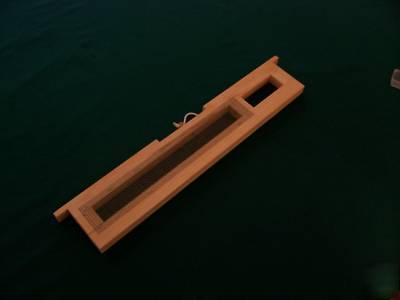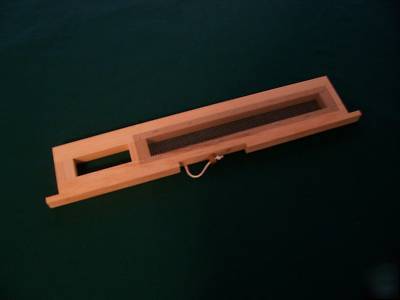Machine Recycling Discussion and Moderated Newsgroup > Full Machines
> Complete Machines
> Woodwworking
> South
> New
> Beekeeping laying worker eliminator queen introduction
Beekeeping laying worker eliminator queen introduction
H&L Bee Farm LAYING WORKER ELIMINATOR & Queen Introducer
WHEN YOU OPENED THAT HIVE AND FOUND IT HAD GONE LAYING WORKER YOU KNEW IT WAS TIME TO CALL THE UNDERTAKER.
Allow me to introduce my little friend.
Say Hello to LAYING WORKER ELIMINATOR!
Any time a hive loses its queen, for whatever reason, the bees start making a new one by selecting some larvae that is the right age and feeding them royal jelly. These larva's are ones that have just hatched from an egg. It takes three days from the time a queen lays an egg for it to hatch into a larvae. Larva's that are older than 24 hours will not work for queen production. So, in some cases, and for any number of reasons, the hive fails to make a queen and all the eggs have hatched and all the larvae is too old, the bees are in big trouble. In an act of desperation, one of the workers will develop ovaries and will start laying eggs. However, her eggs are not fertile, so the only offspring produced by her will be drones. The problem is: All other bees in the hive have accepted her as their queen. Detecting her is impossible because she looks like all the other workers in the hive. This makes introducing a new queen almost impossible because the workers think they have a queen and will kill any new queen introduced, thus putting the hive on a terminal road to dead out. You know this has happened whenever you go into a hive and see all the bullet looking spotty brood sticking out from were the once normal worker brood was. Also, when you see the cells with 2 or 3 eggs in one cell and the bees seem disoriented.
The LAYING WORKER ELIMINATOR will solve this problem.
1. Obtain a new mated queen from your supplier. Request that she be in a standard wooden queen cage with candy and attendants (which is normal).
2. Remove one of the outside frames from the laying worker hive and shift the frames over until you have an opening in the center of the hive leaving room for the Laying Worker Eliminator.
3. Remove the cork from the end of the queen cage that DOES NOT HAVE THE CANDY. Be careful and keep your finger over the hole so the new queen does not escape. Slide it into the queen cage port of the device so that the open end lines up with the hole which leads into the chamber of the device/the screened area). This will allow the queen to be in a safe compartment whee the other bees in the hive cannot ball her. However, for some strange reason, they will feed her through the wire long after her attendants have died, during which time they begin to accept her pheromones over the laying worker's. During the process, they terminate the laying worker. They know who she is. We don't.
4. Make sure the wooden peg is in place on the top of the device and install the unit into the center of the hive. If you have other hives, it would be a big help to swap brood frames with the 2 frames on each side of the device. Also, if the laying worker hive is getting low on bees, you can change locations by swapping places with it and a strong hive. This way, the forager bees will keep pollen and nectar flowing into the laying worker hive.
5. Forget about it for 10 days. Then return and remove the peg from the top of the device. Just put the peg into the spare peg socket and do nothing else in the hive.
6. Come back a week later and make sure the queen is out of the device. If other bees are in there, no big deal. Just prop the device up in front of the hive. In a day or so, they will all have found their way home and your hive is now queen right and thumping again.
Thank You for visiting with us. Feel free to email us for directions or questions to:
Dr. Bill Lyles or TL Hester Phone: (***) 468-7660



